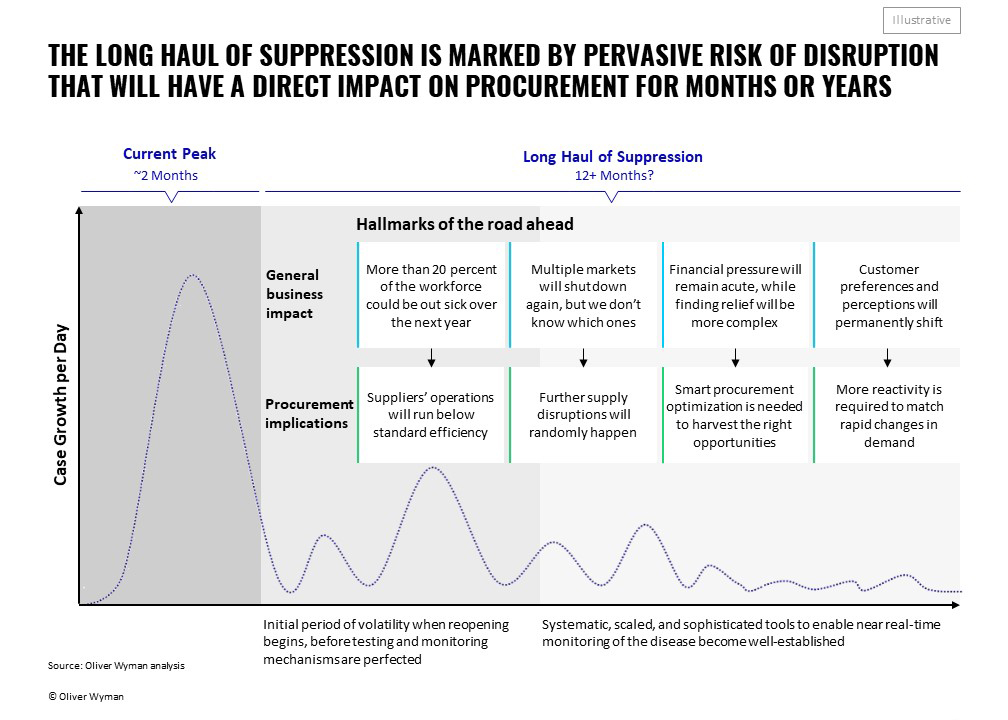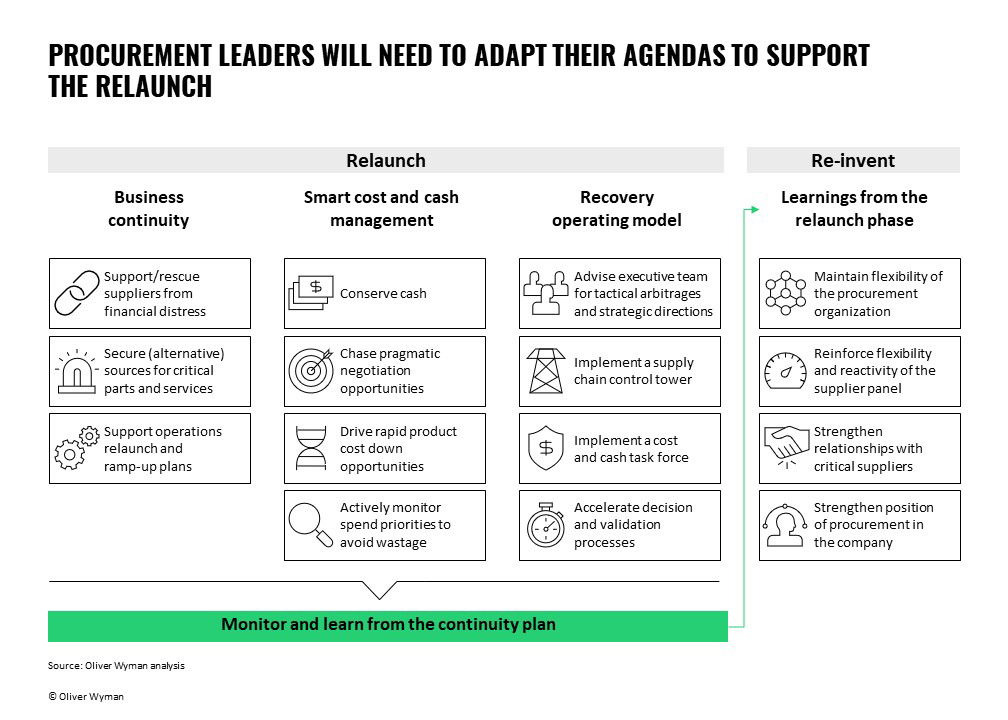A recent Young Presidents' Organization poll of 3,534 chief executives from 109 countries highlights that 51 percent of Chief Executive Officers see the current crisis as a risk to the survival of their company or a severe threat. Sixty percent of those same leaders are preparing for a U-shaped recovery - a long period between recession and an upturn.
From restricted access to credit, to disruption to supplier operating models, and even bankruptcies, it is currently impossible to estimate the extent of the impact, and what lies ahead. This unpredictability is particularly acute for procurement leaders.

During the COVID-19 lockdown period we have spoken to many procurement leaders across a wide variety to industries to understand how they are re-evaluating their agenda to aid resilience and recovery. Many of them are already tackling the difficult questions head-on to identify and respond to new priorities and adjust ways of working.
To steer their firms out of the crisis, many to procurement leaders should temporarily reshape their agenda around three pillars through this volatile period: business continuity, smart cost containment, and using smaller, agile task forces. When done well, these new ways of working could ultimately reaffirm the position and perception of procurement within the organization
When done well, these new ways of working could ultimately reaffirm the position and perception of procurement within the organization
1. Ensure business continuity
The primary role of procurement in current times is to ensure operations can continue or relaunch despite the complicated business environment and plan against many different scenarios. Here, the key objective is to develop a transparent and dynamic view of suppliers’ landscape to anticipate the risk of failure and find alternative solutions with relevant technical or demanding functions. This includes and optimized risk management approach, as well as being close enough to suppliers to anticipate problems early on and being ready to support them.
During this crisis we’ve already witnessed how this has been successfully put into practice. One example is a leading European automotive manufacturer, which set up a business continuity SWAT team at the beginning of March, to make sure that all their factories would be adequately supplied as soon as production started up again. The implementation of this team was very quick as it replicated a similar set up used almost 10 years ago off the back of the Fukushima events, which stopped production in Japan for several weeks and disrupted global automotive supply chains. The team leverages the flexibility of supplier panels and uses alternative sources to match demand. It also identifies critical suppliers in distress and conducts rescue actions to relieve their finances or operations.
2. Manage costs and cash in a smart way
Decreases in revenues and inbound payments have resulted in cash scarcity and companies should carefully safeguard their own cash situation so they can be nimble and lean in the future. Keeping small and medium sized suppliers afloat with early payments is necessary to maintain a healthy and diversified supplier panel. It can also be also used to optimize cost conditions or set the basis for deeper collaboration.
Cost containment is often a complex balancing act with many factors playing a role. One example is a regional telecom operator that, when faced with the adverse effects of both COVID-19 and falling oil prices, mobilized a special internal procurement consulting team to identify areas of cost optimization. In a matter of days, the team screened most of the supplier portfolio to assess where the recent changes would create negotiation opportunities without harming suppliers. As an example, they found out that cable prices would be positively impacted by the drop in the cost of key raw materials such as copper, artificial rubber, and energy. Discussions with suppliers revealed how fast this would reflect in their financials and consequently set the basis for a price revision, beyond the usual contract index adjustments.

3. Mobilize Agile Task Forces
The main focus for procurement leaders and their teams will simply be about re-establishing and maintaining the status quo of business-as-usual, which has its own set of challenges. But as this pandemic is so unprecedented, it is important to be highly vigilant and able to respond rapidly when required. Here, procurement leaders should organize some key individuals into small and agile teams tasked with the responsibility of identifying and assessing the situation. This is known as a control tower task force. Once issues and respective solutions are identified, these can be transferred to the rest of the procurement organization for execution.
We have seen one durable goods manufacturer overhaul their procurement dashboard to allow more effective communication during the executive committee’s daily meetings, which has led to a far clearer call to action. Their Chief Procurement Officer mobilized 11 individuals from category management, operational purchasing, and procurement performance management in a “COVID-19 relaunch control tower” team. The team regroups daily to consolidate information on supplier panel resilience and assign tasks, and the Executive Committee receives a dashboard with eight key performance indicators and a summary of risks and requests.
Preparing to launch, even strive
Remaining competitive or afloat in this turbulent time has no easy answers but investing the time to monitor and learn could make a huge difference. The coming months will be a great experiment to test real-life new ways of working and tools, and to develop closer links between procurement leaders and their teams. Here, procurement’s flexibility, agility, and ability to build strong relationships both internally and externally could have a lasting impact on the survival and success of an organization. Whilst COVID-19 has given procurement functions an added layer of complexity, and many more headaches, it can also be viewed as unique opportunity to try out new ways of collaborating and reinvent the role and path for the future of procurement.
Time is of the essence and the it is imperative that procurement leaders act now to drive transparency, bringing a global and fair vision to all stakeholders. Delivering stringently on risk, cost, and cash should remain a priority. Most of all, procurement leaders must make the time to understand what we have learned from COVID-19, and how this can pave the way for future procurement functions with greater vision and clarity.



